SEPTEMBER 1956
1. NAGLER HELIGLIDER
A 1-man strap-on helicopter-autogyro proposal. Weight about 65 lbs; craft would lift man up rapidly at 2,700 ft/min rate, and carry him five miles. Power for rapid climb would be supplied by 6 rockets arranged radially about hub of rotor.
Each about size of milk bottle, fired in pairs, one for each blade, into a manifold. Rocket blasts through interior of rotor blade, exhausts from supersonic nozzle.
Rockets deliver about 20 lbs of thrust each for a duration of 20 seconds. Fuel is a solid propellant combination. After the rockets are expended and altitude is reached, the craft would go into autorotation, and descends slowly.
Folded, and carried easily, it would cost little and be expendable. Tilting of the rotor disc would provide directional control. Re-powering requires only removal of the spent rockets and installation of new ones.
2. BENSEN “GYRO-GLIDER”
This helicopter-glider was developed by Igor Bensen, and was one of smallest aircraft in world. With a 29ft rotor diameter and weighing only 86 lbs. empty. Operating principle is similar to Fa-330.
The “Gyro-Glider” is towed by an automobile until it becomes airborne; and will stay aloft as long as in tow, or there is sufficient wind to keep rotor blades turning.
Take-off speed is about 20 mph, landing speed of 7 mph, lifting power more than four times its own weight.
The Gyroglider first flew in March 1954; since then over 300 kits for “homebuilders” and 17,000 sets of plans sold.
A water-operating model was also available known as the “Hydro-Glider”. Fitted with floats and of all-aluminum construction, the craft is towed by motorboat.
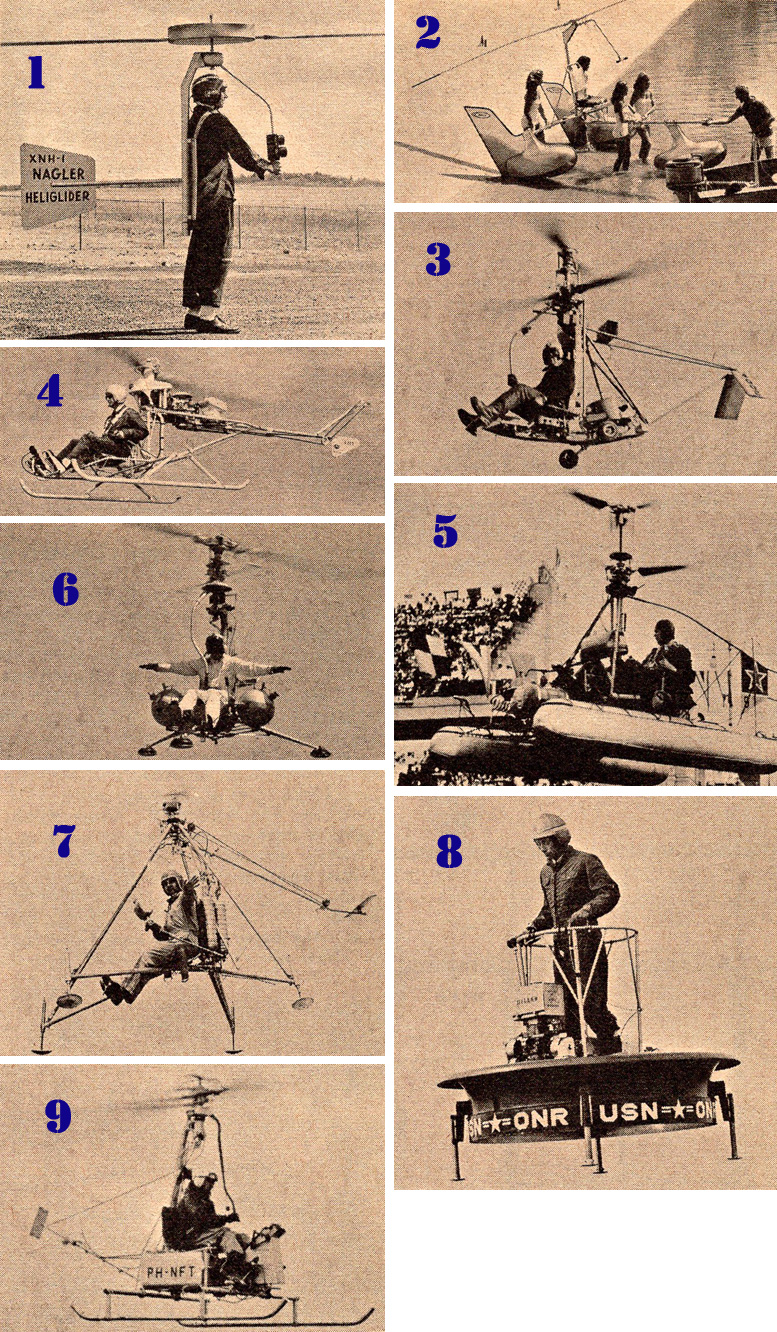
3. GYRODYNE ROTORCYCLE XRON-1
The Rotorcycle was designed, and built, test flown in less than a year on Navy BurAer contract. Used for observation, liaison, and small tactical maneuvers. It requires little time for training, is easy to maintain, and costs little to produce. The helicopter folds into small package for easy transportation.
Power for the coaxial counter-rotating rotor system is provided at present by a single Nelson 40 engine; the 75 hp McCulloch engine was yet to be installed. The rotor system is typically Gyrodyne’s, developed on larger Model 2C coaxial ’copter. It weighs less than 500 lbs.
Thirty designs submitted by 18 manufacturers were considered by Navy; only Gyrodyne and Hiller received contracts for this type craft. Gyrodyne intends to have their XRON-1 certificated for commercial sale. (Gyrodyne Co. of America, Flowerfield, L.I., N.Y.)
4. GOODYEAR 400R “GIZMO”
Produced as a 1-man courier-liaison or tactical vehicle. The initial powerplant was a water-cooled two-cycle outboard Johnson engine developing 33 hp; now fitted with 4 cyl “Mercury” outboard developing 43 hp. Power is supplied to rotors through a belt, pulley system.
Gross weight is slightly more than 400 lbs, top speed 60 knots. Capable of hovering, pattern flight, steep turns, high speed, forward flight, rolling pullouts. Est. service ceiling 12,000′; empty weight 245 lbs; endurance 45 min on 3 1/5 gals of gas; top speed 70 mph, cruising speed 55 mph. Folds into 21″x22″x152″ box.
5. KAMOV K-17 VERTOLET”
A single-seater ultra-light Russian design that appeared in 1948. Powered by a 20 hp Aubier-Dunne motorcycle engine, sporting a 3-bIade coaxial/rotor system. Twin floatation gear makes it amphibious; fitted with a single tail. Designer is the now famous N.I. Kamov.
6. KELLETT KH-15 “STABLE MABEL”
This 1-man rocket-powered helicopter was designed and built by Kellett under sponsorship of the Office of Naval Research to investigate new type of stable control system in small helicopter.
Has been flown “hands off”. Rocket engines located in rotor tips; fuel is hydrogen peroxide carried in two large round tanks. Flew in early 1954. (Kellett Aircraft, Philadelphia International Airport, Philadelphia, Pa.)
7. ROTOR-CRAFT RH-1 “PINWHEEL”
An early configuration was designed with a four-point landing gear. At speeds above 25 mph, the pilot can make left or right turn by extending their hand in direction desired, a la auto signal causing drag and weight shift.
8. HILLER “FLYING PLATFORM”
This stand-on type craft was developed by Hiller under the Office of Naval Research contract. Directional control is accomplished by leaning in direction pilot desires to go. The weight shift craft utilizes principle of lift and propulsion through a ducted fan.
The small diameter rotor is mounted under the pilots platform completely enclosed or “ducted”. Flown as a tactical vehicle; it can be transported with ease fully assembled. Under development since 1947; this was the first such VTO type to achieve piloted free flight.
9. NEDERLANDSE Helicopter Industrie H-2
“Kolibrie”Powered by a ramjet, it was the first rotary wing craft of original design in Netherlands. One/two place utility craft; two rotor-tip ramjets of 55 hp each. Powerplants burn household kerosene, gasoline, or jet fuel. Cruising speed 62 mph, minimum power speed 37 mph.
Gross weight is 1320 lbs, empty weight 440 lbs. Rotor diameter 33 ft. Endurance ½ to 1-hour depending upon use as crop duster/sprayer or military liaison/observation craft. Production models were designated H-3.
10. CAPITAL C-1 “HOPPI-COPTER”
With further development of the Pentecost co-axial came the “HoppiCopter” C-1 powered by two tip-mounted Naval Research Laboratory pulse-jets, 23 lbs thrust each, intended as a light personal one-seater helicopter.
Completed in late 1953, undergone ground testing. It stands over 6ft tall, has an 18ft rotor diameter with a 6ft tread tricycle landing gear. Empty weight, 130 lbs, normal gross weight, 450 lbs.
Designed top speed, 90 mph; cruising speed, 60 mph; max rate of climb 800 ft/min; best climb is 40 mph; max ceiling 10,000ft; endurance 1½ hrs. Est. cost $1300-$1500 in quantities of 1000. (Capital Helicopter Corp, Schenectady, N.Y.)
11. FA 330 by Focke-Achgelis
Produced by Weser Flugzeugwerke of Delmenhort, Germany, this 3-bladed, single-place, auto-gyro glider was normally flown as kite, towed from submarine by cable winch; as an elevated observation post which increased the submarines search view when cruising.
Operators of Fa 330s were submariners taught to fly the craft in a large French wind tunnel at Chalais-Meudon. 200 units completed before end of war, but lost their combative value, because they could be detected by Britain’s newly developed radar technology.
They had a reputation of being quick to assemble and easy to fly, even at very low speeds. This captured one is being tested at Budd Air Force Field, Pa., 1948. Pilot, George Townson.
12. BENDIX HELICOPTERS MODEL K
Designed as a single-seater, co-axial contra-rotating configuration with 2ft 4inch spacing between rotors; according to a number of test pilots, was really the first successful flying co-axial.
The Continental engine provided 92 hp. Rotor diameter of 25ft; overall length 25ft; height, 9⅓ft; empty weight 954 lbs; gross weight 1250 lbs; cruising speed 70 mph; maximum speed 96 mph; range 85 miles; service ceiling 8500ft.
The Model K later was used as a flying test bed for the 5-place Model J; further testing of both craft taken over by Helicopters Inc., with rights later obtained by Gyrodyne Company of America.
The Model K was later turned over to NACA Langley Field for testing, then to the Smithsonian for historical display. First flight was made in June 1945.
13. deLACKNER “AEROCYCLE”
This is the military version of publicly offered DH-4 HELI-VECTOR. Powered by 4 a cylinder, 2 cycle “Mercury” Mk. 55 outboard engine and developing 43 hp.
Prototype is re-engined “Heli-Vector”; Army has ordered 12 “Aerocycles” for field evaluation. Production versions will weigh about 170 lbs, have larger diameter rotor blades, modified transmission, with increased fuel capacity.
This craft will lift a 300 lb payload, fly at 65 mph, have 150 mile range with a hovering ceiling of over 10,000ft with autorotation provided. Outrigger arms fold alongside aligned rotorblades.
14. BENSEN B-4 “SKY SCOOTER”
This design is a one-two place with pilot, passenger sitting on “buddy” type motorcycle seat, handlebar controls. Rotor lift and engine power are controlled by a motorcycle style twisting left the handle-grip, forward speed by pushing and pulling handlebars to alter rotor disc.
Rudder pedals steer the craft right, left. Rotor diameter 29 ft; empty weight 360 lbs; gross weight 740 lbs; cruising speed 60 mph; range 120 miles.
A 40 hp Nelson engine drives two small propellers mounted on rotor blades which supply pulling power for the rotor.
HEPARS Drive system (high efficiency propulsion and rotor system) by Bensen is key to its simplified design, having a low cost . . . $6800 per complete, or $980-$4500 for “do-it-yourself” addicts, depending upon the amount of factory prefabrication. No word regarding ATC tests, no flight views released. (Bensen Aircraft Corp., Raleigh, N. C.)
15. SCHMIDT PULSE-JET “PARA-COPTER” MODEL 2
Front-line evacuation craft; uses Schmidt-designed pulse-jet engines on tips of rotor blades. Such engines are usually noisy, but these have water injected into their chamber which turns into steam in normal 1700 degree heat, creating greater mass, deadening noise.
Remaining noise then changed into higher-pitched, inaudible sound through use of 32 stainless steel tubes mounted in end of ejection chamber.
Engines were hinged so they are always in optimum position regardless of blade-pitch changes.
Each produces 105 lbs thrust. Craft folds into a small package. Height, 8ft; rotor blade diameter, 17ft; est. speed, 132 mph ; duration, 1 hr 10 min.
16. S.N.C.A. SUD OUEST S0-1220 “DJINN”
A 1-place aircraft powered by the 250 hp Turbomeca “Palouste” compressor-turbine unit which actuates the rotor by blowing pressurized “cold” air through its rotor hub and hollow blades, without using combustion at rotor tips.
In production for the French military services and commercial operators in 1-place agricultural configurations; 2-place with enclosed cockpit, or single-place with two-outboard stretchers designated SO-1221.
Pictured with 33 lb radio, pilot, and 132 lbs of useful load has range of 110 miles and a 2 hr endurance. Rotor diameter is 33ft, maximum weight for vertical take-off (SO-1221), 1455 lbs., – this was one of the more prolific craft of its time.
Empty weight, 650 lbs., speed, 75 mph, cruising speed, 62 mph. In December 1953, the “Djinn” set two records by reaching 15,711ft altitude. To sell for about ⅓ price of other 2-3 place certificated helicopters on market. (S.N.C.A.S.O., Pams 16e, France)
17. FAIREY “ULTRA LIGHT”
Designed as a small liaison-observation aircraft and developed for the British Army. It can be transported on standard 3-ton truck, removed manually by bars inserted through skid landing gear.
A 250 hp Blackburn-Turbomeca “Palouste” turbine feeds air to the Fairey designed pressure jets at rotor blade tips. Rotor diameter 28ft 3inches; overall fuselage length 14ft 8inches; height 7ft 11inches; width, 6ft 3inches. Seats two, with pilot forward, observer aft, giving 360 degree vision. First flew in August 1955. Two were built. (Fairey Aviation Co., Hayes, Middlesex, Eng.)
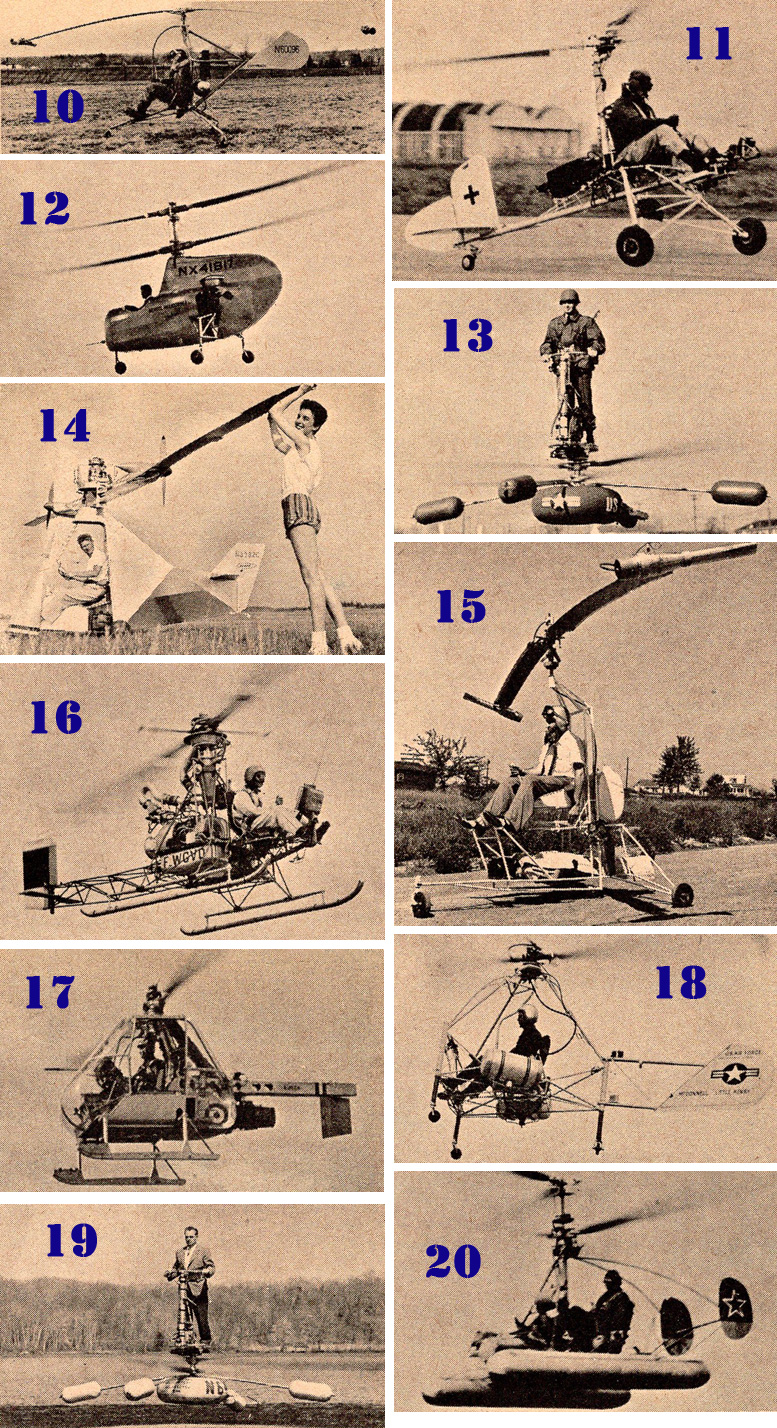
18. MCDONNELL J-I “LITTLE HENRY”
Their first ramjet helicopter built in 1948, for Air Force, intended to demonstrate three-dimensional aerial motorcycle, consisted of 2-blade rotor, two tip ramjets, small rudder, open steel structure supporting pilot, fuel tanks, and control.
Ramjet units, weighed less than 10 lbs each, burned 80 grade octane gas. Weighed 285 lbs empty, the craft an carried additional load of 500 lbs. Dimensions; 5ft wide. 7ft high. 12½ft long.
Rotor blade diameter 18½ft from jet to jet. Two types were built, with the second having refinements such as automatic throttle on collective pitch arm, modified rudder.
One can still be found in the Smithsonian. Speeds of over 50 mph were reached carrying a pilot, passenger. USAF designation XH-20. (McDonnell Aircraft, St. Louis 3, Mo.)
19. deLACKNER “HELI-VECTOR” DH-4 Stand-On
Roll and pitch were accomplished by the pilot shifting his weight forward and backward; right or left directional control was made by turning the motorcycle type handlebars.
The Kiekhaefer “Mercury” outboard engine of 30 hp mounted on platform ahead of the pilot provides power; transmission is dual v-belts with a stable, automatic torque balancing unit and autorotation cam clutch.
Fuel is carried in an upright column, throttle is conventional twist grip motorcycle unit. Counter-rotating rotor blades have a 15ft diameter; prototype weighs 180 lbs. Est. top speed, 65 mph, normal range on 1 gal fuel 15 miles; hovering ceiling 5000ft. First flew in November 1954. (deLackner Helicopters, Inc., Mt. Vernon, N.Y.)
20. KAMOV KA-10 “VERTOLET”
Another Kamov Russian development of the earlier K-17; this time with a 50 hp Pobieda engine. Like the earlier model, it’s fitted with floatation gear, but has a twin tail.
These ultra-lights used by the Russian Navy for observation operations from submarines. Maximum speed about 75 mph.
21. HOPPI-COPTER “STRAP-ON”
This helicopter was designed by Horace Pentecost in 1945 as first an ultra-light, back-strap helicopter. Powered by 15-20 hp engine with 12ft diameter co-axial rotor system; able to lift 200 lbs.
About 25 test hops were logged with safety cables for the pilot in case of equipment failure before the project was ultimately shelved to make way for a model with landing gear. The original “Strap-On” is now on display at the in Smithsonian.
22. HOPPI-COPTERS INC. MODEL 101, 102, 103, 104 – followed Pentecost “Strap-on”
Known as “Hoppi-Copters”, these had a seat and tricycle landing gear. Powerplants were 20 hp for the Model 101, 35 hp for the Model 102, and 40 hp for the Models 103 and 104.
The first two had 16ft and 16½ft diameter, latter two 17ft diameter rotors. The Model 104 was built in 1952 and had a gross weight of 450 lbs, cruised at 45 mph with range of 150 miles. The Model 102 and 104 were tested in England by the British Ministry of Supply.
The Model 104 remained in England fitted with a British light engine; no word has been received since regarding testing by HoppiCopters Ltd. Although Horace Pentecost is no longer with Hoppi-Copters Inc., concern still exists and is supposedly designing new light copter.
23. BENSEN “MID-JET”
Another tiny ramjet designed and built by Igor Bensen in late 1953 for entry into the Naval “Rotorcycle” competition. It weighed 100 lbs, reported capable of lifting 400 lb loads, flying at speeds of up to 80 mph. The ramjets, weighed 5 lbs each, developed 50 lbs thrust each. Rotor diameter was 15ft.
Easily taken apart and reassembled with simple hand tools. Because of simplified design and improved aluminum designed ramjet powerplants, the price would run $1000 per unit in quantity production.
24. AMERICAN HELICOPTER XH-26 “JET JEEP”
Designed as a military development’ of XA-6 for the Ordnance Branch of Army, it flew in 1952. Originally the craft had a twin vertical fin tail, but, reworked and fitted with a new v-tail and small tail rotor. It can be parachuted in 5x5x14 ft container, put together, and ready to fly in 20 minutes.
Powerplants are American Helicopter XAJ 7.5 inch pulse-jets developing 35 lbs thrust each, with only one moving part, which when worn may be replaced in a few minutes. Top speed, 80 mph; cruising speed, 70 mph; empty weight, 300 lbs; gross weight 700 lbs; maximum gross weight 1040 lbs; rotor diameter 27ft; height, 6ft.
It can carry a single man, or two persons in tandem, or side by side with twin external litters without modifications to basic airframe or powerplant. The company has since been absorbed by Fairchild Engine & Airplane Corp. Five were officially ordered.
25. AMERICAN HELICOPTER XA-6 “BUCK PRIVATE”
A single-seater that was flown in February 1951. Powerplants were the company’s own XAJ 6.7 inch pulse-jets developing 35 hp each, having a combined weight of 32 lbs, burning either gasoline, kerosene or diesel fuel oil. Rotor diameter, 27ft, length, 13ft 6inches; empty weight, 180 lbs: gross eight, 720 lbs; cruising speed, 60 mph; range 125 miles.
26. HILLER “HORNET”
This was the HILLER companies first tip-powered ramjet helicopter, flown in 1950. A two-place configuration with a fuselage of steel construction covered with laminated plastic and fiberglass. A tail rotor is used for directional control and was sloped to be affected by rotor downwash. Rotor diameter 23ft; fuselage length 12ft 8inche; height 6ft 8inches; empty weight 340 lbs; gross weight 900 lbs.
Maximum speed, 80 mph; cruising speed 70 mph; rate of climb 1100 ft/min; ceiling 12,000ft; range 50 miles; endurance 40 minutes. The Hiller 8 RJ ramjets weighed 11 lbs and produced 35 hp each.
Originally intended to be marketed for under $5000, but in 1951, the military commitments necessitated canceling the commercial “Hornet”. Three prototypes were constructed, two were stripped, and one was in completed configuration.
27. BENSEN B-7M “GYRO-COPTER”
A powered version of “Gyrocopter” and “Hydro”-Gliders developed by Igor Bensen. Powerplant is 4 a cylinder air-cooled Nelson engine of 40 hp. Cruising speed 60 mph; range 20 miles on 1 gallon of auto fuel. Empty weight, 185 lbs; gross weight 435 lbs. $1795 complete or plans at $25 per set.
Can be stored in a garage, transported on the tail-gate of station wagon or in a small boat trailer. Simple hand wrenches are used for assembly or disassembly. Operating cost $2-3 per hour. First flight December 1955. (Bensen Aircraft, Raleigh-Durham Airport, Raleigh. N. C.)
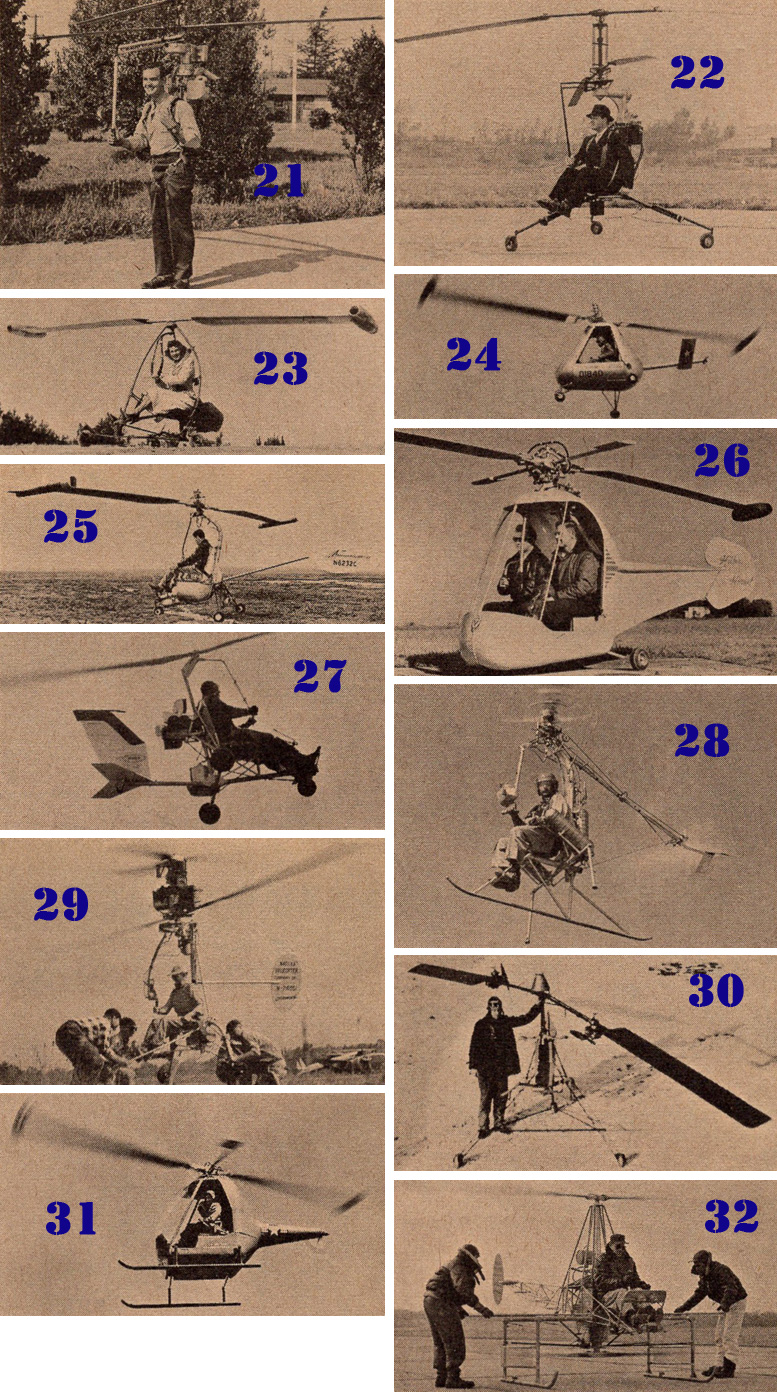
28. ROTOR-CRAFT RH-1 “PIN WHEEL”
The PIN WHEEL, a 1-man, first rocket-powered ‘copter was built for research for the Navy BurAer to investigate rocket power. Powered by liquid hydrogen peroxide fuel; duration, 9 minutes. Flies at 60 mph. Needs no landing gear, uses pilot’s legs for support on take-off and landing. The rocket motors are located in rotor tips, first to be throttle-controlled.
Rotor turns at about 500 rpm, take-off rpm is reached in 10 seconds. The craft is surprisingly quiet, only a hissing sound from rocket jet nozzles is heard. Rotor blades all-metal.
Uses no electricity, has no oil system, hydraulic system, starter, transmissions, or generator; can be folded to fit into phone booth. Conventional helicopter controls, except steering is accomplished by turning cyclic pitch control handle. Commercial version could sell for $1,200. Flown in 1954. (Rotor-Craft Corp., Glendale 1, Calif.)
29. NAGLER NH-120
The NH-120 was designed as a 1-man, collapsible-portable helicopter. Intended as torque-less, gearless, clutchless coaxial craft with simplicity of a single rotor. Drone engine modified, placed between rotors as self-contained power package.
40 hp Nelson engine proved unsatisfactory; it was decided to enlarge the configuration which required engineering change. Craft retained as test bed for newer model.
The NH-120 could fold into 2½x7 ft container; had 7 ft diameter upper rotor; 20 ft diameter lower rotor; overall length 8 ft; height 9 ft; empty weight 280 lbs; gross weight 750 lbs; top speed 80 mph; cruising speed 70 mph; rate of climb 1200 ft/min; endurance was 8 hrs.
30. NAGLER-ROLZ 54
This craft was powered by two 8 hp Argus engines, each weighing 9 lbs, located on rotor blades. The first 1-man, portable helicopter weighing only 80 lbs, built and flown during WW II.
Hitler placed engineering staff and a machining factory at Nagler’s disposal to develop this new kind of machine; four were built, flown before the contract was canceled. Endurance was 1 hour, range 30 miles, ceiling was 1,500ft. Rate of climb was 500 fpm. Rotor diameter 26ft. First flew in 1941 in Austria .
31. HILLER YHJ-1/YH-32/HOE-1
Another HILLER is military configuration based on Hornet” ordered in June 1952. Using more developed ramjet, the 8RJ2b which weighed 12.7 lbs and developed 45 hp, military craft were also fitted with small tail rotor to give quicker, more positive directional control.
Empty weight of redesigned military craft slightly more than 500 lbs. H-32 Army’s first operational ramjet copter, HOE-1 Navy’s first tip-mounted jet copter., HJ-1 “Hiller-Hornet” This was the first jet-powered aircraft of any type to receive CAA certification in the U.S. (in 1955).
A limited and undisclosed quantity of H-32/HOE-1s were delivered for evaluation. Powerplants have no moving parts, and may be changed quickly with a simple screwdriver. (Hiller Helicopters, Inc., Palo Alto. Calif.)
32. NAGLER NH-160
The NH-160 was undergoing flight testing as an unusual ultra-light coaxial rotor configuration with the upper rotor 6 ft above lower. Production models will have the high-speed lower rotor fully shrouded, enclosed cockpit and fuselage. The lower rotor is 3 bladed, and the upper a two blade rotor. A 72 hp McCulloch drone engine rotates the blades.
Upper rotor diameter 20 ft; lower rotor 7 ft; fuselage length 12 ft; overall width 6 ft; empty weight 420 lbs; gross weight 850 lbs. 120 mph. (Nagler Helicopter Co., Westchester County Airport, White Plains, N.Y.)
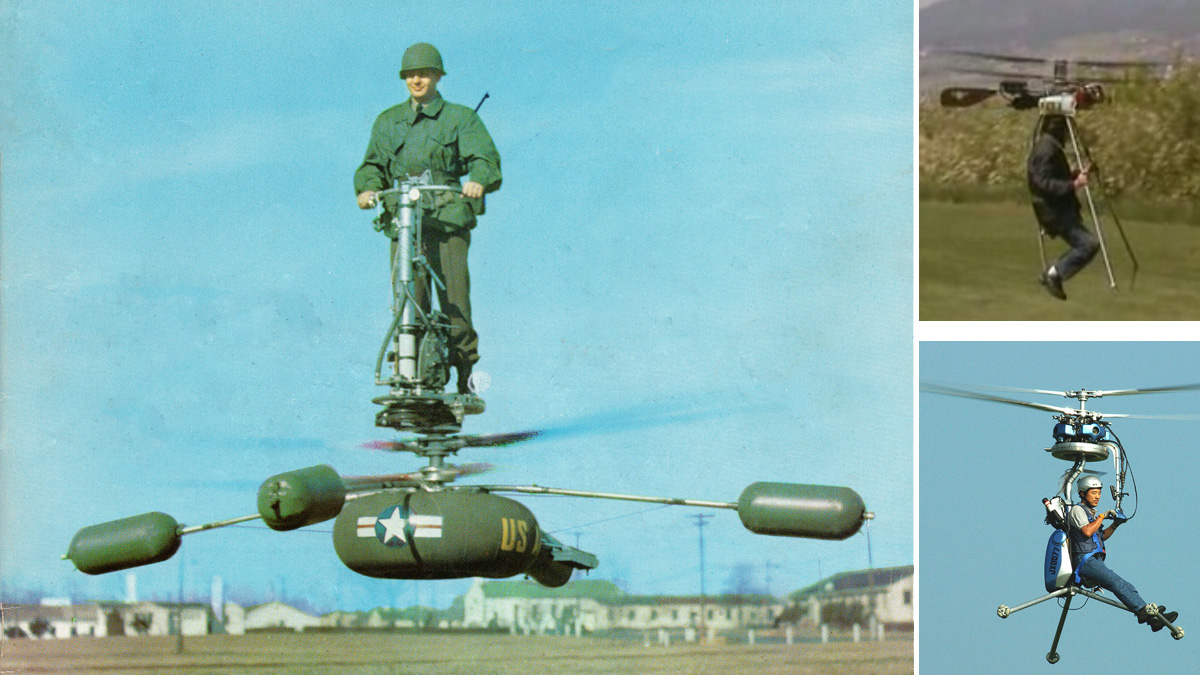

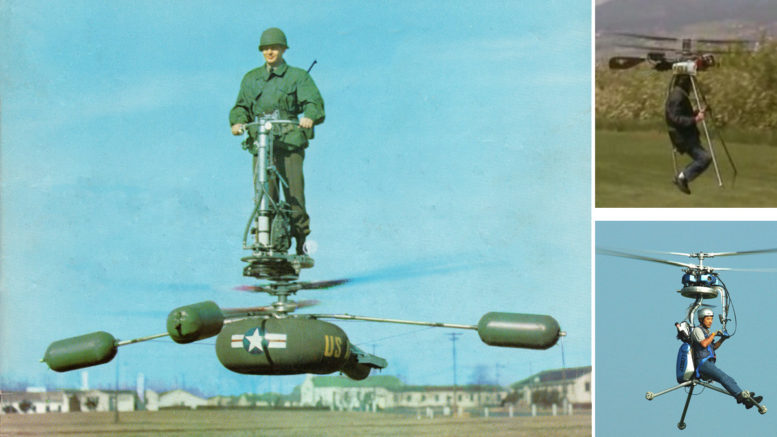
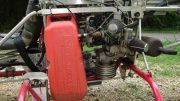
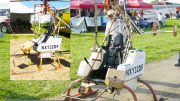
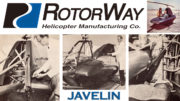
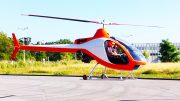
Excelent..!!